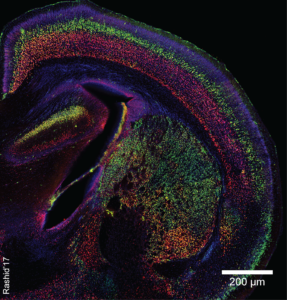By Tegan McCaslin, 28 February 2019
The boring answer to that question is, “Yes, birds.” But that’s only because birds can pack more neurons into a walnut-sized brain than a monkey with a brain four times that size. So let’s forget about brain volume for a second and ask the really interesting question: neuron per neuron, who’s coming out ahead?
You might wonder why I picked birds and primates instead of, say, dogs and cats, or mice and elephants, or any other pair of distinct animals. But check out this mouse brain:

See how, on the outside of the lobe (the part closer to the upper righthand corner), you can pick out a series of stripes in a neat little row? Those stripes are the six layers of the neocortex, a specifically mammalian invention—all mammals have it, and no one else does. People have been pointing to this structure to explain why we’re so much better than fish since the scala naturae fell out of favor.
And that would be a pretty convenient story if birds hadn’t come along and messed the whole picture up. If you look at a similar cross section of a bird’s brain, it kind of just looks like a structureless blob. For a long time, comparative neuroanatomists thought birds must be at a more primitive stage of brain evolution, with no cortex but huge basal ganglia (the bit that we have sitting under our own fancy cortex). But we’ve since realized that this “lower” structure is actually a totally different, independently-evolved form of cortex, which seems to control all the same areas of behavior that mammalian cortex does. In fact, birds have substantially more of their brain neurons concentrated in their cortices than we mammals have in ours.
Alright, so it’s not that surprising that another form of cortical tissue exists in nature. But could it really work as well as ours? Surprisingly, no one has really tried to figure this out before.
If, for instance, primates were head and shoulders above birds, that might mean that intelligent brains aren’t just energetically expensive (in terms of the energy required for developing and operating neurons), they’re also exceptionally tricky to get right from a design standpoint. Of course, if bird and primate architectures worked equally well, that doesn’t mean brains are easy to get right–it would just mean that evolution happened to stumble into two independent solutions around 100 million years ago. Still, that would imply substantially more flexibility in neural tissue architectures than the world in which one tissue architecture outstripped all others.
Answering the question of birds vs. primates conclusively would be an enormous undertaking (and to be honest, answering it inconclusively was a pretty big pain already), so instead I focused on a very small sample of species in a narrow range of brain sizes and tried to get a really good sense of how smart those animals in particular were, relative to one another. I also got 80+ other people (non-experts) to look at the behavioral repertoire of these animals and rank how cognitively demanding they sounded.
With my methodology of just digging through all of the behavioral literature I could find on these species, full and representative coverage of their entire behavioral repertoire was a major challenge, and I think it fell well short of adequate in some categories. This can be a big problem if an animal only displays its full cognitive capacities in one or a few domains, and worse, you might not even know which those are. I think this wasn’t as big an issue with the species I studied as it could have been, since we have pretty good priors with respect to what selective pressures drove cognitive development in the smartest animals (like primates and parrots). Plus, scientists are much more likely to study the most complex and interesting behaviors, and those are very often the ones that display the most intelligence.
One of the behaviors scientists are really keen on is tool use. Our survey participants seemed to like it too, because they rated its importance higher than any other category, and it ended up being the most discriminatory behavior, too–neither the small-brained monkey nor the small-brained parrot had recorded examples of tool use in the wild, while both of the larger-brained animals did.
In the end, people didn’t seem to think the two primate species I included acted smarter than the two bird species or vice versa, but did think the larger-brained animals acted smarter than the smaller-brained animals. The fact that this surveying method both confirmed my intuitions and didn’t seem totally overwhelmed by noise kind of impressed me, because who knew you could just ask a bunch of random people to look at some animal behaviors and have them kind of agree on what the smartest were? That said, we didn’t validate it against anything, and even though we have reasons to suspect this method works as intended (see the full article), how well and whether this was a good implementation aren’t clear.
So this is all pretty cool, but even if we could prove definitively that macaws and squirrel monkeys are smarter than grey parrots and owl monkeys, it’s not a knock-down argument for architecture space being chock full of feasible designs, or even for birds and primates having identical per-neuron cognitive capacity. It’s mostly just a demonstration that the old self-flattering dogma of primate exceptionalism doesn’t really hold water. But it also points to an interesting trend: instead of trying to tweak a bunch of parameters in brains to squeeze the best possible performance out of a given size, evolution seems to have gotten a lot of mileage out of just throwing more neurons at the problem.
There’s a lot more dirt here, in the full analysis.



1 Trackback / Pingback